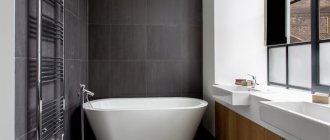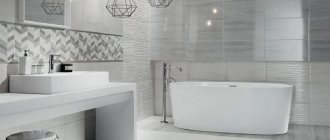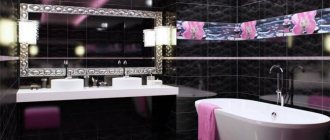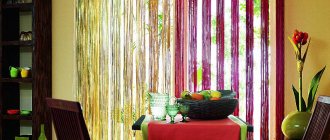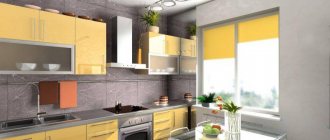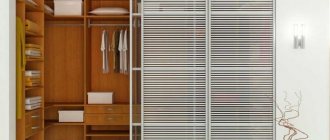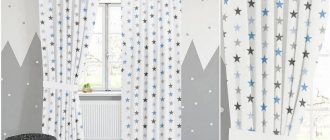How to choose linoleum for the kitchen?
When selecting a coating, take into account the following recommendations:
- When choosing this product, its hygroscopicity plays an important role.
- The coating must have minimal slip even when wet, and be resistant to abrasion and stress.
- When using a thin linoleum sheet, to avoid defects and imperfections on the surface, you need to carefully level the base.
- To decorate a small or narrow kitchen, it would not be appropriate to lay a colorful covering. Here it is better to use flooring in light shades with a glossy surface or a diagonal pattern.
- It is desirable that the color of the linoleum matches the set.
- When choosing, you should pay attention to the labeling, since the kitchen coating must have increased antiseptic characteristics.
The photo shows the interior of a small kitchen with light-colored linoleum on the floor.
Dark colors
Before laying linoleum in a black or dark brown shade, you should think about it. On such a coating, the slightest remnants of bread or even small spots are very clearly visible, which means that cleaning will need to be done frequently. If the choice falls on such shades, then it is better to add furniture in light colors; the walls should also be painted white or beige. Dark shades make the room noble, but it is recommended to use them only in spacious kitchens.
Pros and cons of linoleum in the kitchen
Main advantages and disadvantages.
| pros | Minuses |
| It is quite elastic, soft and elastic. | May have a temporary odor. |
| It is easy to clean, has good water-repellent properties and prevents the appearance of mold and mildew. | Over time it fades and turns yellow. |
| Antistatic and attracts less dust. | Does not withstand certain mechanical influences and aggressive detergents. |
| Some types, due to their rough or embossed surface, are non-slip. |
Types of linoleum for flooring
Based on thickness, susceptibility to abrasion and the presence of a protective layer, coatings are divided into three main classes:
- Commercial. It is made of polyvinyl chloride and most often has a single-layer structure without additional backing. The commercial type is hygienic, fire-resistant and has a powerful protective layer that can significantly increase the strength and durability of the product.
- Semi-commercial. It is considered quite wear-resistant. It consists of a felt and synthetic base, due to which this coating better retains heat in the room.
- Domestic. Universal, moisture-resistant, elastic, easy to care for, comes in a wide range of colors and has a foam and felt base.
The photo shows semi-commercial blue linoleum on the floor in the kitchen interior.
Thickness
Homogeneous products consist of one layer. The thickness of linoleum does not exceed 3 mm, so the material is not in high demand. A multilayer (heterogeneous) coating is a composition of several materials with a durable base, intermediate layers, decorative finishing and a protective layer. Thickness varies in the range of 3-6 mm.
Household linoleum has a protection thickness of 0.2-0.25 mm, semi-commercial - 0.4-0.6 mm, commercial - 0.6-0.8 mm. The middle option is suitable for the kitchen. With the same “pedestrian” load, the material will last at least 5-7 years
A more important value is not the thickness of the linoleum, but the height of the transparency, which optimally should be 0.5 mm
Recommendations for choosing material
Natural ecological linoleum contains lime powder, cork conglomerate, linseed oil, resin and natural coloring pigments, which are applied to a jute and linen base.
Among artificial ones, there are glypthal, rubber, colloxylin types, as well as hypoallergenic and safe PVC coatings, which have high moisture resistance, strength, elasticity, resistance to mechanical stress and a huge number of colors and patterns. It can be multi-layered heterogeneous or consisting of one layer - homogeneous.
The photo shows a kitchen interior with a red linoleum PVC covering on the floor.
The main advantage of liquid self-leveling linoleum is its smooth and even surface without seams. This material is made from high-quality processed polyurethane and epoxy resin.
Preparatory work before installation
Most suppliers offer to install linoleum sheets, but recognize that buyers can do everything themselves.
The surface on which you want to lay linoleum must be smooth, clean, dry, without any impacts, dirt, oil or paint.
When installing, it is recommended to add a deck underlayment. You can use either a cork lining, which helps reduce noise, or plastic, which provides excellent moisture protection.
To lay linoleum you will need the following tools:
- well-sharpened knives for cutting fabric;
- serrated steel spatula (150-200 mm);
- wooden spatula;
- long ruler;
- chalk;
- double-sided tape, mastic or glue;
- optionally – liquid for welding seams.
Linoleum sheets can be installed over an existing floor as long as it is securely attached to the subfloor. If this is not the case, then you need to get rid of it. If plank flooring is installed in the kitchen, then before installing linoleum, the boards are covered with plywood and screwed with self-tapping screws.
Advice! While working on preparing the floor, you should definitely lay out the linoleum somewhere nearby for a couple of days so that the canvas acclimatizes to room temperature. In an insufficiently warmed state, the linoleum sheet is too fragile.
How to choose the color of kitchen linoleum?
Choosing a color scheme for the kitchen cover also requires a competent approach.
Black
It is a sign of respectability and undoubtedly turns into the main detail of the entire room. Black luxurious floor finishing, especially in combination with light walls and high-quality lighting, will form a laconic and harmonious design.
The photo shows black dark linoleum in a Scandinavian-style kitchen.
White
It will give a feeling of lightness and cleanliness, visually expand spatial boundaries and further focus attention on furniture items.
Brown
It has a stylish, solid and luxurious look and is a classic solution for giving the interior a dignified and majestic image.
Green
A natural herbal green tint will add a touch of freshness to the environment and will become the most noticeable, bright and effective decoration of the room.
The photo shows the floor in the kitchen, decorated with green linoleum.
Grey
Due to its neutrality, it is considered a fairly common color, which always looks very noble and stylish.
Yellow
It will charge the kitchen atmosphere with a positive and good mood, and also compensate for the lack of natural light.
The photo shows a kitchen combined with a dining room with a floor covered in matte yellow linoleum.
Beige
It will give the atmosphere individuality, aristocracy, good taste and endow the space with warm and positive energy. In addition, if yellowing occurs, it will be less noticeable on a beige coating.
The photo shows light beige linoleum in the interior of a kitchen in the Provence style.
Light coloring pages
A white or other light-colored finish will be the perfect backdrop for each headset. If the kitchen is small, then visually it will become much larger. If the ceilings are painted white, then the floors need to be made a little darker. On light shades, stains or crumbs are less noticeable, especially if you use a coating that imitates natural textures.
Linoleum design in the interior
Thanks to various designs, you can choose the most suitable design that will ideally complement the overall interior picture.
Linoleum with a tile pattern
It is a fairly popular design solution that allows, at low cost, to obtain a coating with a high-quality imitation of the texture of tiles, cavities and joints between tiles.
Imitation laminate
Linoleum for laminate, parquet or boards has a very reliable appearance, is distinguished by a wealth of visual effects and a variety of color shades from light wood to dark wenge, due to which it is possible to create a calm and cozy interior. When choosing this product, it is important to take into account the correct direction of parquet or laminate strips and colors, depending on the features of the kitchen.
The photo shows the interior of a modern kitchen with linoleum imitation laminate boards.
Combined flooring in the kitchen
Linoleum goes well with other finishing materials, such as tiles, porcelain stoneware, laminate or parquet. In this way, it is possible to create a specific interior composition, focus attention on the necessary spatial areas and implement visual zoning of the kitchen. You can also add special individuality to the atmosphere if you combine linoleum of different colors, textures or patterns.
Marbled
It will give the design originality, a certain exoticism, will further emphasize the style and original interior design, and will also become an independent decoration that creates a magnificent and presentable environment.
The photo shows linoleum flooring with imitation light marble in the kitchen interior.
Imitation weed
It looks like natural grass, which allows you to create a beautiful, natural and most natural atmosphere in the space.
Geometric designs
Fashionable prints with zigzags, squares, ovals, circles, diamonds, checkered or striped coverings can not only set a certain character for the kitchen, but also influence its spatial perception in different ways.
Geometric or abstract figures can set the atmosphere as rhythmic and dynamic, as well as calm restraint and tranquility. With the help of large patterns, it is possible to create the necessary accents in the room, and thanks to small patterns, it is possible to add spaciousness and airiness to the space.
The photo shows the floor in the kitchen, decorated with linoleum with a geometric pattern in the form of multi-colored diamonds.
Patterns and prints
A variety of patterns, ornaments and unusual abstractions allow you to dilute the strict and monochromatic kitchen design and fill the atmosphere with a certain mystery and coziness. Linoleum with 3D prints has the illusion of three-dimensional space and realistically conveys the volume of the picture.
The most popular coating colors
An example of linoleum with imitation walnut parquet
Despite the emergence of many synthetic floor coverings that create an alternative to natural materials, at the peak of popularity, as before, are the colors inherent in various types of wood: oak, beech, cherry, ash, pine and wenge. In this regard, we can distinguish three “leaders” from the entire variety of colors:
- Brown. Great for creating an interior in country or Provence style. Warm shades of brown make the atmosphere in the room more homely and cozy. In addition, they have a calming effect on the nervous system, so they are recommended for use in decorating bedrooms and living rooms;
- Walnut. The warm shade of linoleum will not disturb the idyll of the classic style. This floor can be combined with light furniture and fairly bright interior accessories: paintings, panels, vases, etc.;
- Bleached oak. To this day, the vintage style remains in fashion, so the “aging” effect is not inferior to its position and the flooring of this shade allows you to emphasize the sophistication of the chosen style.
Options for finishing linoleum walls
To finish walls or aprons, use a product made of polyurethane polymer, which, due to its high elasticity, makes it possible to cover a wide variety of surfaces, corners, bends and protrusions. Wall linoleum is considered a very promising and creative way of decoration and can imitate natural fabric, masonry, leather, tiles and other materials.
Abstraction
Ornament in the form of geometric shapes allows you to balance spatial solutions and hides many design errors.
Having determined the desired color spectrum, you should not rush to purchase - you need to familiarize yourself with the other characteristics of the coating.
Release size and form
Traditionally, linoleum is produced in rolls 1.5-5 meters wide and 6 meters long (technical - up to 45 m). Considering that the average size of a kitchen in a typical typical apartment is 5-6 square meters. m., the material has to be cut and adjusted.
Before purchasing, you need to decide on the required quantity of goods, for which the floor area is calculated and 5-8 cm is added to the resulting value for possible shrinkage.
To avoid painstaking adjustments, two revolutionary new forms of flooring were created:
Linoleum for the kitchen under tiles, that is, in the form of square or rectangular panels. They are easy to adjust to all corners of the room, and replace if necessary (for example, if an area is stained or burned), but during installation a lot of seams are formed, which is undesirable for the kitchen;
Liquid linoleum. The popularity of self-leveling floors is steadily growing due to significant advantages: no seams, complete waterproofing, hygiene. The coating can become the basis for traditional linoleum flooring.
What is better to choose for the kitchen: linoleum, tiles or laminate?
Linoleum is often used to decorate a kitchen, but many also prefer tiles or laminate as cladding. Each type of coating has its own advantages and disadvantages.
| Linoleum | Tile or laminate |
| It is durable, depending on the type, it can last more than 15 years. | Laminate boards have a service life of up to 10 years. In addition, laminate and some types of tiles are not impact resistant. |
| Easy to clean using any detergent. | |
| The felt-based covering absorbs noise well. | Some tough stains on laminate flooring are very difficult to remove. |
| It may differ in various imitations, for example, the texture of wood, stone and others. | Tile and laminate are harder and have poor thermal and sound insulation properties. |
| Has a lower price. | |
| This coating is much easier to lay and dismantle. | Easily imitate a wide variety of materials. |
Compared to laminate and tiles, linoleum is a better option for the kitchen.
Factory marking
Like any artificial material in Russia and Europe, linoleum is manufactured according to international GOST.
The class of linoleum for the kitchen can be easily determined by the marking, consisting of four numbers:
- 21-23. Intended for residential use only;
- 34-31. Can be used in offices;
- 41-43. Flooring for industrial enterprises.
The letter code located immediately after the number indicates the degree of abrasion of the product: F - strong, MP - medium, T - weak.
